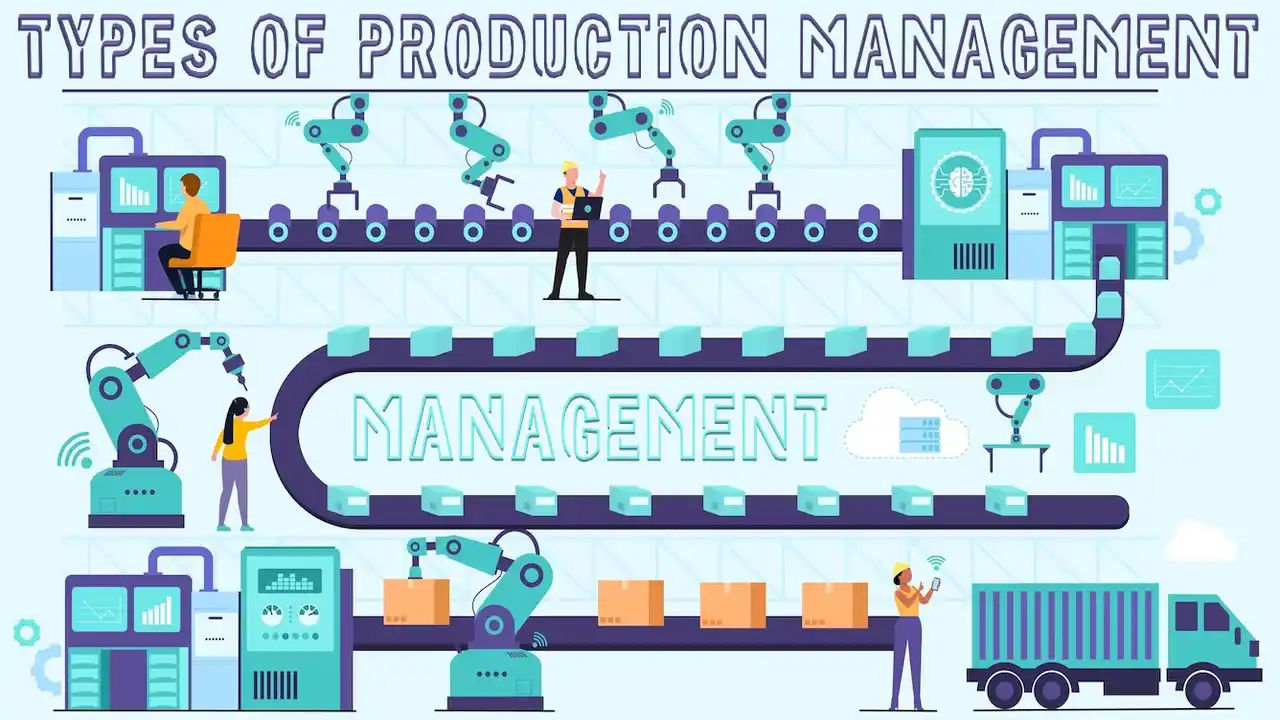There are many moving parts in every production plan, and they all need to mesh into a coherent strategy with clear output goals. The production plan’s overarching goal is to make full use of all inputs and outputs. You should take stock of your current resources before making any purchases to avoid duplicating purchases. We’ll look at the types of production management and talk about the related topics in this area.
Planning for future production of a company’s goods is known as production planning. Creating a framework for how production should work and pinpointing regions with low productivity, this strategy is crucial for 21st-century manufacturing.
Types of Production Management
picking and buying stuff like supplies, workers, land, tools, and money. The method of production for an item can be learned from how it is designed. Products and services emerge from their respective inputs.The successful transformation requires close monitoring and control. Many different production techniques exist. A production manager’s job is to find the best approach for his department. The product and the intended amount must be taken into account while deciding on a method. Here is an overview of types of production management with a detailed explanation for your better understanding.
Periodic Manufacturing Process
It’s a mode of production with no set schedule for when it starts and stops. Products are made in very tiny batches on an as-needed basis in an intermittent production system. The rate of output is fluctuating in this case. The actual decision relies on whim and market forces.
It’s a really flexible creative process. It produces a wide range of products in numerous sizes and shapes, always adapting to satisfy the needs of its customers. A goldsmith’s trade is typical of the haphazard nature of construction techniques. It’s not always the case that he makes stuff (decorations). Instead, he makes them as he needs them, in very small batches. The frequency with which his customers submit orders is crucial to his ability to do his job.
Job Order Flows in Production
Jobbing manufacturing flows produce products in compliance with exact client requirements. They finished the production on schedule and under budget. A business sets the price of a product when signing a contract. Job assembly lines are common in businesses that fix things, make clothes, make specialist gear, etc.
Producing in Batches
For this type of production, they set the timeline according to anticipated demand or specific customer requests. They manufacture the goods in large numbers and store them securely until needed. Each component of the product now has a specific job to do. Not until the preceding batch’s tasks are finished will the next batch of output begin. This encompasses the manufacturing of everything from massive machinery to pharmaceuticals.nbsp;
Batch manufacturing involves repeated steps and predicts output quantity accurately. Each part of the process is done independently, moving to the next phase when the previous is finished. For example, a company aims to produce fifty electric motors, completing each batch through the phases sequentially. Job production involves the same group working on each part of the machine. Large batch sizes benefit from repeated production. Thus, batch production involves creating a product in successive steps, completing each step on the entire batch before moving to the next. Types of production management involves producing goods in batches, where each batch goes through a specific set of production processes.
An Influx of Mass Production
Businesses mass-produce items and warehouse them until needed in the market. They can use one or more independent procedures to manufacture a product. Simple examples of mass-produced goods include bar soap, tube toothpaste, and ballpoint pens. Flow production, online mass production, or continuous manufacturing involves producing several goods all at once. In flow production, the process quickly processes each component of the product before moving on to the next stage. The manufacturing process entails a number of steps. The object moves on to the next phase as soon as the current one is finished. There is no pause in between the end of one process and the start of another. The rate of output has been steadily increasing.
Flow production shares several features with mass production. When mass-producing things with consistent specifications, this technique shines. People commonly use machines to provide this kind of output, which helps keep prices down. Some factories use single-item assembly lines. The time savings will allow the factory to crank out more goods. The decrease in the price of production has allowed factories to increase their profits. This approach to planning ensures timely operations within the constraints of available resources.
Continuous Goods Generation System
In a system with continual production, all production operations happen at once and rarely stop or behave unpredictably. They continually manufacture and sell things in large quantities here. They set inputs and outcomes simultaneously with the manufacturing process, with no consideration given to consumer desires.
Supply Chain Management
One product is manufactured in large quantities and kept in stock until it is needed. Because they only generate one byproduct, these plants are not particularly useful. Famous products like paper, sugar, cement, and steel are all included here.nbsp;
Scheduling and Production Control
In this role, you’ll be responsible for keeping an eye on production to make sure everything is running smoothly. The goal is to take prompt action if anything goes awry and to keep things moving along smoothly otherwise. A fundamental part of any successful business. The act of planning out when workers will start and stop working on a project is known as production scheduling. Types of production management focuses on producing unique, custom-made products tailored to individual customer requirements.
Anticipate the Flow of Production
It’s an agreement between two businesses to carry out a single, complex transaction within a predetermined price range and time window. Transportation infrastructure includes building infrastructure such highways, waterways, trains, and airports. Companies do not make all of these products in large quantities. Moreover, businesses must devote significant time, money, people, and technology to delivering on these commitments.
Creating Employment
Producing a product in response to a buyer’s request creates employment opportunities. It’s not uncommon for produced goods to have their own unique characteristics. Creating a single item is an example of a solitary operation. Constructing a product or piece of equipment involves assembling various materials, parts, and components. Examples of work creation include the building of ships, dams, and bridges, as well as the writing and printing of books.
When one worker or multiple workers work together to make a product, this is known as job-based or project-based production. One tiny operation that could benefit from production planning is making a one-of-a-kind piece of jewelry. Custom home building and other large, intricate manufacturing projects fall under this umbrella as well. Planning a manufacturing run is a breeze when dealing with simple operations that need for only a few specialized instruments.
This enables the creation of products to order, allowing adjustments as needed without halting manufacturing.
Method of Flow
Passage manufacturing defines the constant movement of products through the assembly line, responding to fluctuating client demand. This is a typical step in the manufacturing process for electronics like televisions. A sequence of coordinated group actions continuously transfers inputs to outputs, resulting in the product’s creation. Besides, businesses can reduce their stockpiles of WIP and finished goods by switching to the flow production approach. So, it cuts expenses and speeds up production, too.
Product Production Technique
The steady movement of components along the assembly line is a hallmark of process manufacturing, as it is of mass production and passage production as well. When goods are manufactured in this way, they are rarely counted as individual units. For instance, the processing and manufacturing of liquids, gases, and chemicals that adhere to strict uniformity and standardization. At every step of the Process Method, they use precision and cutting-edge technology to manipulate materials. There is minimal space for error in this types of production management because changing from one product to another takes so long. It is well-known that this production method can create waste and byproducts.
FAQ
What Traits Define Effective Production Managers?
Managers in production oversee a staff with a wide range of experience, education, and expertise. A strong leader skillset is essential for a production manager. Leadership is critical because it is the proof of successful production management that the requirements for safety and efficiency are met.
What Makes Production so Crucial?
Manufacturing is a vital part of any successful enterprise. Having more people working the land is good for the economy. The increased availability of goods and services due to increased output also contributes to a higher standard of living.
How can a Production Manager Excel?
The ability to convey your ideas clearly to your coworkers, superiors, and customers. You need negotiation skills if you want to get things on time and at a fair price. the aptitude for handling a number of tasks at once while maintaining high standards of performance. Ability to inspire others to work toward a common goal is essential, as is leadership experience.
Summary
An in-depth production plan outlining the actions to take to meet client needs is the first stage in effective production management. This process relies heavily on careful planning and scheduling in order to meet strict quality and delivery deadlines without sacrificing either. In this guide, we’ve explained types of production management. I hope that provided you with some useful knowledge. To stay updated with the latest insights on functions of production manager, read regularly.






